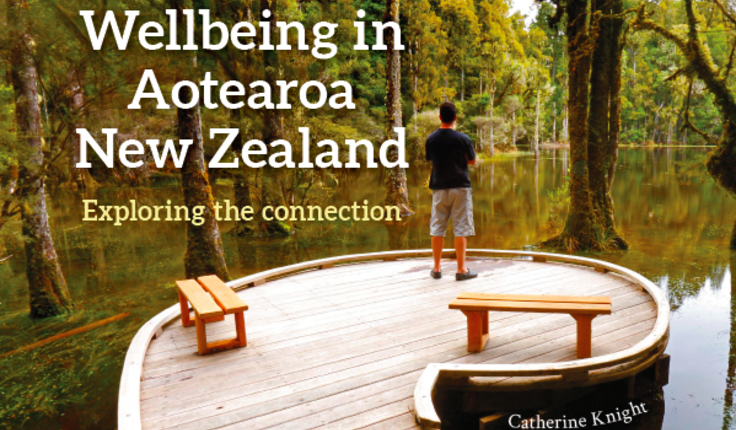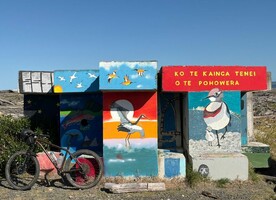News
New book argues for more nature in our cities.
Posted 08 10 2020
in News

We have never been more aware of the benefit of being out in nature, but how much quality time does the ‘average’ New Zealander spend enjoying the outdoors? While our national parks are places of spectacular wilderness, for many of us, these places are out of reach.
This ground-breaking book argues for the restoration of ‘neighbourhood nature’ – places that all New Zealanders can freely access, irrespective of socioeconomic or other factors. New Zealand’s experience of the coronavirus pandemic underscores how important these local oases of nature are – and how vital they are to our wellbeing.
Richly illustrated throughout, this book tells the stories of a wide range of New Zealanders, who – either individually or through organised initiatives – have experienced the wellbeing benefits gained through connection with nature. Their stories are varied but each one is authentic, personal and moving. Drawing on the latest scientific research and through these personal stories, Knight challenges us to contemplate a more nature-rich future.
In her new book examining the link between nature and wellbeing, environmental historian Dr Catherine Knight explores the benefits of nature experienced by everyday New Zealanders, and argues for more nature in the places where most New Zealanders live – our towns and cities.
In New Zealand, we think of ourselves as a country rich with nature, but the fact is that most of our surviving forest and pristine waterways are concentrated in the most mountainous parts of the country. They’re preserved not as a result of careful stewardship, but rather an accident of history: it was just too hard to develop and economically exploit these rugged, inaccessible places. Our lowland landscapes are largely bereft of any forests, wetlands or any nature in its original form.
This means that to experience nature in its pure, indigenous sense, most of us have to travel some distance; it is not something we can step out of our back door and do. But many New Zealanders do not have the luxury of taking long holidays to walk or camp in one of our spectacular national parks. Yet, we know from the accumulating body of evidence from research undertaken all around the world that being in nature – even for a relatively short time – is good for us, both for our physical and mental wellbeing.
One of the earliest studies to conclusively make such links was undertaken in 1991, and found that a 40-minute walk in nature led to significant improvements in mood, reduced anger and aggression, and also to better recovery from mental fatigue compared with walking in an urban space or reading a magazine. In more recent studies, exposure to nature or urban green space has been associated with lower levels of stress, reduced symptoms of depression and anxiety, and improved cognition in children with attention deficits and individuals with depression.
Moreover, research suggests that the benefits of growing up with access to lots of green space has a lasting effect into adulthood. A Danish study published in 2019 found that children who grow up surrounded by green spaces are less likely to develop mental disorders as adults.
Nature exposure has also been shown to boost immunity. Studies have foundthat forest therapy excursions boost the activity of “natural killer cells” (a type of white blood cell that plays a vital role as part of the body’s defence system, attacking infections and tumours) and elevate hormones that may be protective against heart disease, obesity and diabetes – at least over the short term.
Researchers have been careful to factor out the beneficial effects of energetic physical activity when designing their studies of nature exposure, by asking participants to sit quietly or take a gentle walk. So this is good news for those of us who prefer a stroll to strenuous exercise. What’s more, researchers have found that just 20-30 minutes in nature delivers optimal benefits (after that, they continue to accrue, but at a slower rate).
And the even better news is that to provide these benefits, nature does not need to be remote or pristine – a leafy park, a stream-side walkway, or even a quiet, tree-lined avenue can provide this “nature fix”.
The lockdown experience led many of us to realise how important our neighbourhood green spaces are – for walking, cycling, or just getting some fresh, tree-filtered air. During April this year, citizen science apps such as iNaturalist reported an upsurge in usage, indicating that people were getting out into nature in their neighbourhoods.
Our appreciation of nature at this time of crisis is not without irony, given that at the root of the pandemic is the unprecedented destruction of pristine forests, rapid urbanisation and population growth, bringing wildlife and human activities into constant and dangerous proximity and making wildlife-to-human transmission of new diseases increasingly likely. According to Livia Esterhazy, World Wildlife Fund New Zealand chief executive, Covid-19 has been a “really clear warning signal … [that] we have a world and an environment completely out of balance. The rise of pandemics is absolutely linked to the destruction and the loss of nature.”
But the lockdown also accentuated inequities in our society – not just here but in the United States and elsewhere. For those of us who live in the country or in the leafy suburbs, having more time to spend in local parks or walking along a river or coastal walkway would have felt more like a gift than an imposition. But for those living in neighbourhoods with few places to enjoy nature, or those that did not have the luxury of working from home due to their jobs or circumstances, connecting with nature may not be a priority.
Eighty-six percent of us live in cities and towns, and we lead busy lives. So if we are going to ensure that everyone is able to benefit from spending time in nature, we need more nature spaces in our cities. This does not necessarily mean more parks. With the right care and green investment, long-neglected stream corridors, weed-infested gullies, flood-prone areas unfit for development and even road verges can provide valuable greenspace for humans, while at the same time creating a network of habitat for the insects, birds and reptiles that keep our natural ecosystems functioning.
In Nature and Wellbeing in Aotearoa New Zealand: Exploring the connection, I put out a challenge to all New Zealanders – and especially our city planners and our decision-makers: to strive for a more nature-rich future, an Aotearoa where every New Zealander can benefit from being in nature, any day of their life.
Nature and Wellbeing in Aotearoa New Zealand by Dr Catherine Knight
Available now from all good bookstores, or order from Nationwide Book Distributors
* Excerpt courtesy of The Spinoff
19 Dec
Christmas break 2025

see you from 12 January
As we wrap up another big year, we’re taking a moment to pause, breathe, and enjoy a well-earned break. Meri …
18 Dec
President’s update

December 2025
Earlier this month I attended the Ngā Aho Māori Design Professionals Wānanga-ā-Tau at Te Aranga Marae in Flaxmere. Tuia Pito …
18 Dec
Awards 2026 update

An update as we warm up for the 2026 Awards kaupapa. Submissions will open in March and will run for …
Events calendar
Full 2025 calendar